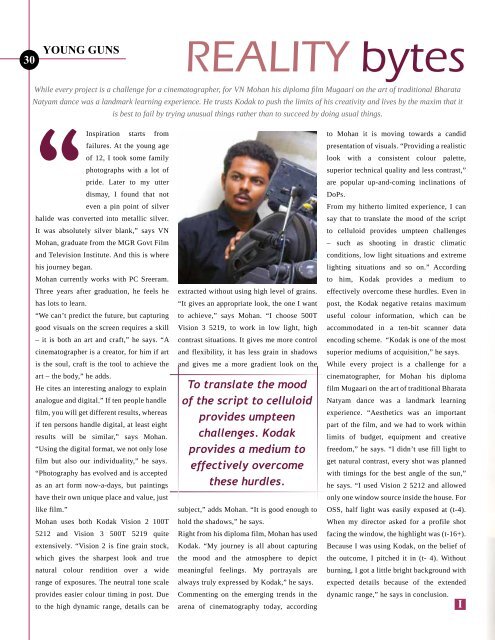READ MORE ABOUT AlsO fEATURED fOCUs ON - Kodak
READ MORE ABOUT AlsO fEATURED fOCUs ON - Kodak
READ MORE ABOUT AlsO fEATURED fOCUs ON - Kodak
You also want an ePaper? Increase the reach of your titles
YUMPU automatically turns print PDFs into web optimized ePapers that Google loves.
30<br />
YOUNG GUNS<br />
REALITY bytes<br />
While every project is a challenge for a cinematographer, for VN Mohan his diploma film Mugaari on the art of traditional Bharata<br />
Natyam dance was a landmark learning experience. He trusts <strong>Kodak</strong> to push the limits of his creativity and lives by the maxim that it<br />
“Inspiration starts from<br />
failures. At the young age<br />
of 12, I took some family<br />
photographs with a lot of<br />
pride. Later to my utter<br />
dismay, I found that not<br />
even a pin point of silver<br />
halide was converted into metallic silver.<br />
It was absolutely silver blank,” says VN<br />
Mohan, graduate from the MGR Govt Film<br />
and Television Institute. And this is where<br />
his journey began.<br />
Mohan currently works with PC Sreeram.<br />
Three years after graduation, he feels he<br />
has lots to learn.<br />
“We can’t predict the future, but capturing<br />
good visuals on the screen requires a skill<br />
– it is both an art and craft,” he says. “A<br />
cinematographer is a creator, for him if art<br />
is the soul, craft is the tool to achieve the<br />
art – the body,” he adds.<br />
He cites an interesting analogy to explain<br />
analogue and digital.” If ten people handle<br />
film, you will get different results, whereas<br />
if ten persons handle digital, at least eight<br />
results will be similar,” says Mohan.<br />
“Using the digital format, we not only lose<br />
film but also our individuality,” he says.<br />
“Photography has evolved and is accepted<br />
as an art form now-a-days, but paintings<br />
have their own unique place and value, just<br />
like film.”<br />
Mohan uses both <strong>Kodak</strong> Vision 2 100T<br />
5212 and Vision 3 500T 5219 quite<br />
extensively. “Vision 2 is fine grain stock,<br />
which gives the sharpest look and true<br />
natural colour rendition over a wide<br />
range of exposures. The neutral tone scale<br />
provides easier colour timing in post. Due<br />
to the high dynamic range, details can be<br />
is best to fail by trying unusual things rather than to succeed by doing usual things.<br />
extracted without using high level of grains.<br />
“It gives an appropriate look, the one I want<br />
to achieve,” says Mohan. “I choose 500T<br />
Vision 3 5219, to work in low light, high<br />
contrast situations. It gives me more control<br />
and flexibility, it has less grain in shadows<br />
and gives me a more gradient look on the<br />
To translate the mood<br />
of the script to celluloid<br />
provides umpteen<br />
challenges. <strong>Kodak</strong><br />
provides a medium to<br />
effectively overcome<br />
these hurdles.<br />
subject,” adds Mohan. “It is good enough to<br />
hold the shadows,” he says.<br />
Right from his diploma film, Mohan has used<br />
<strong>Kodak</strong>. “My journey is all about capturing<br />
the mood and the atmosphere to depict<br />
meaningful feelings. My portrayals are<br />
always truly expressed by <strong>Kodak</strong>,” he says.<br />
Commenting on the emerging trends in the<br />
arena of cinematography today, according<br />
to Mohan it is moving towards a candid<br />
presentation of visuals. “Providing a realistic<br />
look with a consistent colour palette,<br />
superior technical quality and less contrast,”<br />
are popular up-and-coming inclinations of<br />
DoPs.<br />
From my hitherto limited experience, I can<br />
say that to translate the mood of the script<br />
to celluloid provides umpteen challenges<br />
– such as shooting in drastic climatic<br />
conditions, low light situations and extreme<br />
lighting situations and so on.” According<br />
to him, <strong>Kodak</strong> provides a medium to<br />
effectively overcome these hurdles. Even in<br />
post, the <strong>Kodak</strong> negative retains maximum<br />
useful colour information, which can be<br />
accommodated in a ten-bit scanner data<br />
encoding scheme. “<strong>Kodak</strong> is one of the most<br />
superior mediums of acquisition,” he says.<br />
While every project is a challenge for a<br />
cinematographer, for Mohan his diploma<br />
film Mugaari on the art of traditional Bharata<br />
Natyam dance was a landmark learning<br />
experience. “Aesthetics was an important<br />
part of the film, and we had to work within<br />
limits of budget, equipment and creative<br />
freedom,” he says. “I didn’t use fill light to<br />
get natural contrast, every shot was planned<br />
with timings for the best angle of the sun,”<br />
he says. “I used Vision 2 5212 and allowed<br />
only one window source inside the house. For<br />
OSS, half light was easily exposed at (t-4).<br />
When my director asked for a profile shot<br />
facing the window, the highlight was (t-16+).<br />
Because I was using <strong>Kodak</strong>, on the belief of<br />
the outcome, I pitched it in (t- 4). Without<br />
burning, I got a little bright background with<br />
expected details because of the extended<br />
dynamic range,” he says in conclusion.<br />
I

















